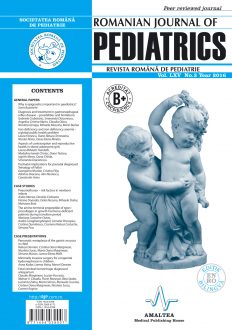SELECT ISSUE

Indexed

| |

|
|
|
| |
|
|
|

|
|
|
|
|
|
|
HIGHLIGHTS
National Awards “Science and Research”
NEW! RJP has announced the annually National Award for "Science and Research" for the best scientific articles published throughout the year in the official journal.
Read the Recommendations for the Conduct, Reporting, Editing, and Publication of Scholarly work in Medical Journals.
The published medical research literature is a global public good. Medical journal editors have a social responsibility to promote global health by publishing, whenever possible, research that furthers health worldwide.
FETAL CEREBRAL HEMORRHAGE DIAGNOSED ANTEPARTUM
Bela Szabo, Claudiu Mărginean, Claudiu V. Molnar, Cosmin Rugina, Cristina Oana Mărginean, Florin Rozsnyai, Lucian Puscasiu, Luminita Zahiu, Manuela Cucerea, Marta Simon and Nicoleta Suciu
ABSTRACT
The diagnosis of fetal cerebral hemorrhage (HCF) is less reported (0,9/1000 births) in comparison to the postpartum one. We presented 2 cases of fetal intraventricular hemorrhages diagnosed.
Case 1: HCF diagnosed by ultrasound at the gestational age of 28 weeks and confirmed after birth by the presence of erythrocytes (significant number, pathological aspect) in the spinal fluid and by the modifications signaled by the transfontanellar ultrasound (severe internal hydrocephaly, minimum cerebral tissue). The death occurred after 24 hours postpartum (pathological exam: intraventricular cerebral hemorrhage). We mention the apparent lack of maternal risk factors, negative TORCH tests.
Case 2: internal hydrocephaly at the age of 37 gestational weeks and confirmed in newborn (after cesarean section) by the clinical characteristic modifications, severe neurological impairment with modification at the transfontanellar ultrasound and the hemorrhagic and hypertensive aspect of the spinal fluid. We did not encounter maternal risk factors. Also, apparently, there were not any fetal risks: weight 2,820 grams at 37 gestational weeks, negative TORCH tests, negative cultures and CRP. The hydrocephaly had a progressive evolution imposing ventriculotomies and cysternotomies; the placement of a ventriculoperitoneal shunt during the third neurosurgical intervention improved the vital prognosis.
Conclusions. The presence of hydrocephaly was a faithful ultrasound sign for the diagnosis of HCF. The evolution and the prognosis are influenced by the severity of hemorrhage and the gestational age. The survivors benefit from neurosurgical treatment. The multifactorial etiology, of the HCF incompletely elucidated leads to difficulties in establishing a target group of screening, in order to identify this lesion.
Keywords: cerebral hemorrhage, antepartum diagnosis
